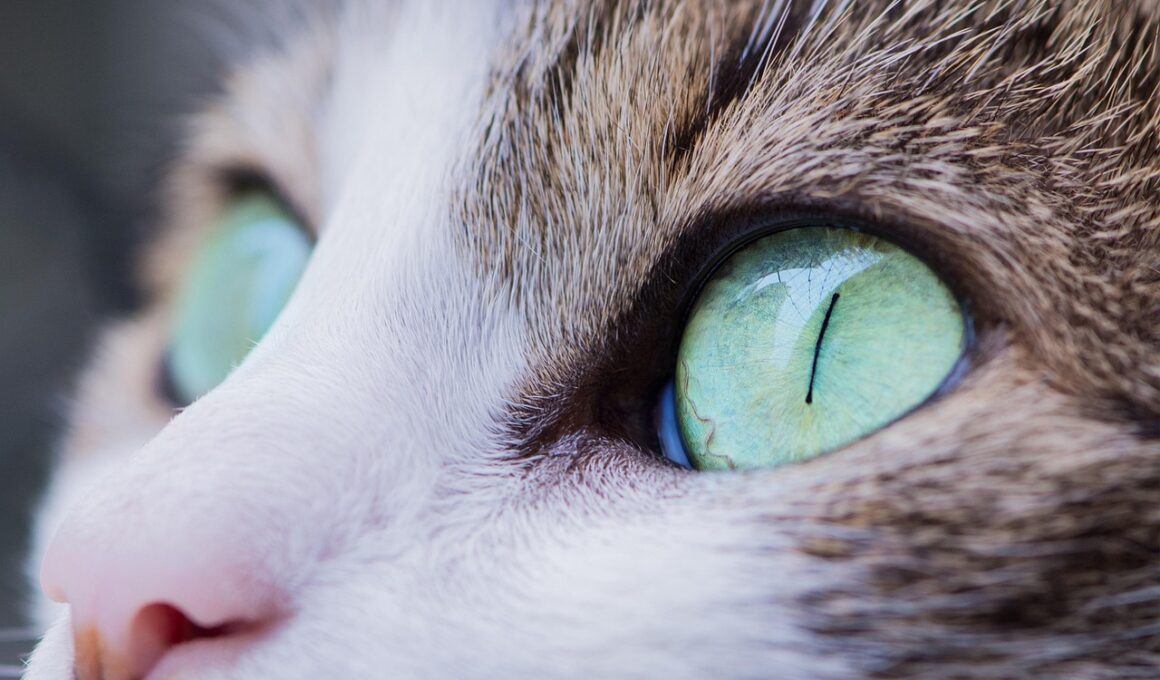Feline Giardia: Myths and Facts Every Cat Owner Should Know
Giardia is a common intestinal parasite found in cats, often leading to gastrointestinal distress. Many cat owners are often unaware of the signs and symptoms of Giardia infection in their pets, leading to misconceptions about the disease. It is essential to understand how Giardia affects your cat, its transmission, and prevention measures. Feline Giardia primarily affects kittens and young cats with compromised immune systems. The parasite can thrive in unsanitary conditions, so ensuring a clean living environment is crucial. Additionally, understanding its life cycle can assist in preventing reinfection. Owners should be vigilant in monitoring their cats for symptoms such as vomiting and diarrhea. If you suspect Giardia, consult a veterinarian immediately for proper diagnosis and treatment options. It is important to note that while Giardia infections are treatable, prompt action can prevent severe health complications. Keeping your cat’s living space clean and sanitary is vital to minimize infection risks. Regular check-ups with your veterinarian can also help ensure your cat remains healthy while addressing any potential infections promptly.
Myth: Giardia is harmless and not contagious to other pets. In reality, Giardia can be contagious among pets, especially in multi-pet households. Cats can spread the parasite through contaminated water, food, or surfaces, making hygiene paramount. If one pet is infected, isolation and sanitation should be immediate. Additionally, Giardia can also impact humans, particularly those with weakened immune systems. Understanding the transmission of this parasite is crucial for the health of all household members. Regularly cleaning food and water bowls and ensuring good sanitation of your cat’s litter box can significantly help in preventing the spread. Owners should also be aware of the risk factors associated with Giardia. Cats stressed or weakened by other illnesses are more susceptible. Furthermore, outdoor cats can easily come into contact with contaminated elements, increasing their risk of infection. Preventative measures may include regular veterinary check-ups and staying updated on vaccinations. Also, avoid allowing your cat to drink from stagnant water sources, as it is a common way for transmission to occur. Being knowledgeable about these factors can substantially enhance your cat’s health.
Recognizing Symptoms of Feline Giardia
Recognizing the symptoms of Feline Giardia is essential for early detection and treatment. Common signs include sudden diarrhea, weight loss, lethargy, and vomiting. These symptoms often mimic other gastrointestinal disorders, so proper diagnosis through veterinary examination is crucial. If your cat exhibits these signs, don’t panic; prompt veterinary care can effectively address the situation. Testing for Giardia usually involves stool samples to confirm the presence of the parasite. Treatment typically includes medication aimed at eliminating Giardia and may also involve dietary adjustments. It’s essential to follow your veterinarian’s guidelines carefully for the best outcomes. The presence of Giardia can lead to dehydration, especially in young or ill cats, so prioritize hydration during this period. Cats suffering from Giardia may show significant discomfort, which may also affect their behavior and eating habits. Monitoring these symptoms closely can prevent complications from arising and can facilitate quicker recovery. Cat owners should also keep records of their cat’s health to provide thorough information to their veterinarian during visits, ensuring accurate diagnoses. Staying informed about Giardia and its signs will protect your feline friend.
Myth: Giardia is solely a gastrointestinal issue. While Giardia primarily affects the intestines, its impact can extend beyond treating digestion problems. Some cats may face secondary infections due to a weakened immune system, emphasizing the need for immediate attention. Ignoring initial symptoms may lead to further health complications, affecting your cat’s overall well-being. Furthermore, while Giardia can decline after treatment, ensuring your cat’s surroundings remain clean is integral in preventing a relapse. Cat owners might assume that once treated, their cat is safe, which is misleading. Regularly observing behavioral changes and ensuring a holistic approach to care can enhance recovery. Nutrition plays a critical role in supporting your cat’s recovery. Integrating a balanced, nutritious diet can help boost the immune system to fight off infections. Also, less stress can facilitate recovery better. Creating a safe, calm environment can aid in this regard. Employ sanitation practices, such as regularly washing litter boxes and ensuring a clean water supply. Education is crucial for pet owners to comprehend that Giardia requires comprehensive care and attention beyond the immediate symptoms. Keeping informed can guide you in optimizing your cat’s health.
Prevention Strategies for Feline Giardia
Understanding prevention strategies for Feline Giardia can significantly reduce infection risks in cats. First and foremost, ensure personal hygiene practices are always observed when handling your cat or cleaning litter boxes. This includes washing hands thoroughly after handling pet waste. Regularly cleaning your cat’s environment is vital for effective prevention. Bacteria and parasites thrive in dirty conditions; therefore, a clean litter box and feeding area are necessary. It’s also essential to provide fresh, clean water at all times, particularly in multi-pet households. Monitor your cat’s health and observe for any unusual changes that may signal an infection. Vaccines are also available for various diseases; consult with your veterinarian to explore options that may suit your cat. Furthermore, educating yourself about the specific conditions that increase your cat’s risk of Giardia can help you mitigate them. Regular veterinary visits will assist in monitoring and diagnosing potential issues early, maintaining overall well-being. Engaging in preventative measures proactively can extend your cat’s health span, ensuring they live a longer, happier life. Commit to routine maintenance and observation of your pet’s health.
Myth: Only outdoor cats can get Giardia. This is a common misconception among cat owners. Indoor cats can also contract Giardia, especially if they share litter boxes or eat contaminated food. Furthermore, bringing items into the home, such as groceries from outside, can pose risks to indoor cats. Even a brief outing on a leash can expose them to contaminated areas, as Giardia eggs can exist in environments such as moist soil or stagnant water. Pet owners often underestimate the impact of contamination from shoes or clothing, bringing indoors hidden pathogens. Ensuring that indoor environments are sanitized will significantly reduce the risk of infection for all cats. It’s also essential to monitor the health of any new pets introduced into the home, regardless of their living conditions. Being vigilant about new additions can help prevent potential outbreaks. In addition, educating visitors on the necessary sanitation practices when interacting with your pet is critical. This can serve to create a protective barrier for your cat. Understanding that indoor cats are not immune to Giardia will help owners adopt safer practices to ensure their pets remain healthy.
Conclusion: Protecting Your Feline Friend
In conclusion, being well-informed about Feline Giardia allows cat owners to take proactive steps toward protecting their pets. It’s crucial to dispel the myths surrounding this intestinal parasite while educating yourselves on recognizing symptoms, treatment, and prevention. Staying vigilant about cleanliness and monitoring your cat’s health can significantly reduce the likelihood of infection. Ensure that your pet receives regular veterinary care and follow their advice to manage and safeguard your cat’s well-being. The bond between you and your feline friend deserves your full commitment to their health. By understanding the implications of Giardia infections, cat owners can navigate the complexities of lifestyle adjustments and maintain a clean living space. Make it a habit to keep learning about pet health and maintaining still a close relationship with your veterinarian for comprehensive insights. Over time, these practices can help maintain long-term health benefits for your pet. Committing to these strategies forms the foundation for a healthier environment, safeguarding the happiness and vitality of your cat. Together, you can create a fulfilling life while minimizing the risks posed by Feline Giardia and other parasites.
Understanding Giardia’s Life Cycle
Feline Giardia’s life cycle is essential to grasp for adequate prevention and management of this parasite. Giardia exists in two forms: the trophozoite and the cyst. The trophozoite stage is the active form that can multiply in the intestines, while the cyst stage is the dormant and resistant form found in the environment. Cats typically become infected when they ingest cysts from contaminated food or water. Once consumed, cysts transform into trophozoites in the intestines, where they can cause symptoms. After reproducing, these trophozoites shed back into the environment as new cysts through feces. These cysts can survive for extended periods, making it easy for them to spread. Consequently, maintaining a clean and hygienic environment is critical. Regularly cleaning areas where your cat roams will prevent re-infection and transmission to other pets in the home. Both the home and outdoor surroundings require attention to mitigate risks. The life cycle’s understanding can empower cat owners to take responsible steps towards eradicating Giardia infections. The importance of thorough education can help prevent future outbreaks and promote improved feline health.


